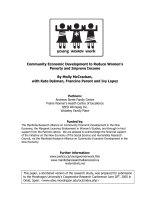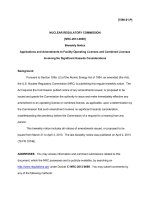Macro to micro porous ceramic and carbon media philosophy of design and fabrication
Bạn đang xem bản rút gọn của tài liệu. Xem và tải ngay bản đầy đủ của tài liệu tại đây (13.47 MB, 400 trang )
MACRO TO MICRO POROUS CERAMIC AND CARBON
MEDIA – PHILOSOPHY OF DESIGN AND FABRICATION
CHEN XINWEI
B. Eng. (Hons.), NUS
A THESIS SUBMITTED
FOR THE DEGREE OF DOCTOR OF PHILOSOPHY
DEPARTMENT OF CHEMICAL AND BIOMOLECULAR
ENGINEERING
NATIONAL UNIVERSITY OF SINGAPORE
2012
Declaration Page
i | Page
DECLARATION
I hereby declare that the thesis is my original work and it has been written by me
in its entirety. I have duly acknowledged all the sources of information which
have been used in the thesis.
This thesis has also not been submitted for any degree in any university
previously.
Chen Xinwei
25 October 2012
Acknowledgements
ii | Page
Acknowledgements
First and foremost, I would like to express my sincere gratitude to my supervisor,
Associate Professor Hong Liang for his invaluable guidance and advice, remarkable
encouragement and continuous support throughout my PhD project, without whom the work will
not be achieved. Prof. Hong’s uncompromising and prudent attitude towards research has
influenced me deeply. His cheerful, approachable nature and dedication to work and students is
widely shared and deeply admired. Special mention also goes to Prof. Chung, Tai-Shung and Dr.
Liu Zhaolin for providing me the opportunities and necessary support to showcase my research to
the scientific world, both locally and internationally.
I would also like to thank my colleagues, Mr. Sun Ming, Dr. Liu Lei, Dr. Guo Bing, Mr
Zhao Xiangcheng, Ms. Aklima Afzal, Mr. Zhou Yi’en, Mr. Chen Fuxiang, Ms. Wang Haizhen,
Dr. Gong Zhengliang and Dr. Yin Xiong for their friendship and support during my time PhD
course. Particular thanks go to Mr. Ng Kim Poi for providing help and advice on the fabrication
and design of experimental apparatus.
I would like also like to thank my FYP students who have contributed to my research.
They include: Ms. Chen Xinling, Mr. Lee Chin Yong, Mr. Tai Xiaohua, Mr. Au Yeong Wen Hao,
Ms. Chan Wan Ki Isabel, Ms. Lim Qing Yue Janice, Ms. Phua Ji Ying Rina, Mr. Ong Zheng Wei
Benjamin, Mr. Kim Min Woo, Ms. Lim Jia Fang, Mr. Khoo Kian Guan and Mr. Tan Ming En
Benjamin. I would like to thank the laboratory staff: Ms Yanfang, Ms Alyssa Tay, Ms Sandy, Mr.
Alistair Chan and Mr. Ang Wee Siong for their care and ever-readiness to assist.
I’m also extremely grateful to by beloved family members for their love and support
throughout the time of the PhD course. I would like to thank my fiancée, Ms. Tan Yan Yan for
Acknowledgements
iii | Page
her understanding and patience. I thank God for them and their unconditional love, understanding
and I would like to give praise to HIM for whatever I have achieved.
Finally, I would like to thank all the staff in National University of Singapore (NUS),
Institute of Material Research and Engineering, Singapore (IMRE) and NRF grant (R279-000-
261-281) for supporting my research work.
Table of Contents
iv | Page
Table of Contents
Declaration Page i
Acknowledgements ii
Table of Contents iv
Summary xii
Abbreviation xv
List of Figures xxi
List of Tables xxxvi
Chapter 1 : Introduction 1
1.1 Motivation and Overview 1
1.2 Research Objectives 3
1.3 Structure of thesis 5
Chapter 2 : Background and Theory for Porous Ceramics 12
2.1 Introduction to Ceramics 13
2.2 Overview of ceramic fabrication technology 13
2.3 Powder processing – role of additives in consolidation 15
2.3.1 Solvents 15
2.3.2 Dispersants 16
2.3.3 Binders 17
2.3.4 Plasticizers 19
2.4 Forming techniques for green body 21
2.4.1 Pressing 21
2.4.1.1 Die Pressing 21
2.4.1.2 Isostatic Pressing 22
2.4.2 Casting methods 23
Table of Contents
v | Page
2.4.2.1 Slip casting 24
2.4.2.2 Tape casting 25
2.4.3 Sol-gel processing and gel-casting 25
2.5 Sintering – Grain growth, pore evolution and its thermodynamics 29
2.5.1 Grain growth 29
2.5.2 Thermodynamics of sintering 29
2.5.3 Pore evolution 31
2.6 Macro-porous ceramic forming techniques 33
2.6.1 Replica technique 34
2.6.2 Sacrificial template method 36
2.6.3 Direct foaming method 37
Chapter 3 : Background and Theory for Carbon Membrane 39
3.1 Introduction 40
3.2 General preparation of carbon membrane 41
3.3 Selection of polymeric precursors 43
3.3.1 Polyimides and its derivatives 43
3.3.2 Phenolic resin 45
3.3.3 Polyfurfuryl alcohol 46
3.3.4 Polyacrylonitrile 47
3.4 Pyrolysis process 49
3.5 Transportation mechanism in CMS membrane 53
3.5.1 Viscous flow 54
3.5.2 Knudsen Diffusion 54
3.5.3 Surface Diffusion 55
3.5.4 Molecular Sieving 55
3.6 Carbon molecular membrane performance for gas separation 57
3.6.1 Robeson Plot 57
3.6.2 Important gas separation for carbon membrane 58
Table of Contents
vi | Page
Chapter 4 : An In-Situ Approach to create Porous Ceramic Membrane:
Polymerization of Acrylamide in a Confined Environment 60
4.1 Introduction 61
4.2 Experimental 64
4.2.1 Preparation of YSZ particles with polymer binder 64
4.2.2 Fabrication of YSZ pellets and in-situ solid state polymerization 65
4.2.3 Fabrication of sintered porous ceramics – heat treatment process 66
4.2.4 Characterization of the polymerization process 66
4.2.4.1 Investigation of polymerization heat of acrylamide in the green pellet 66
4.2.4.2 Analysis of polyacrylamide formed in the YSZ green pellets 67
4.2.5 Characterization of the sintered ceramics pellets 67
4.2.5.1 Porosity, pore size distribution and micro-pore structures 67
4.2.5.2 Gas permeation test 68
4.2.5.3 Measurement of modulus of rupture – 3-point bending test 69
4.3 Results and Discussion 70
4.3.1 Polymerization in the confinement environment 70
4.3.2 Microstructure created by the polyacrylamide formed in-situ 76
4.3.3 Correlation of gas permeability and modulus of rupture with pore-forming history
81
4.4 Conclusions 86
Chapter 5 : Submicron Scale Exclusion via Polymerizing an Aromatic Nylon in
Molded Ceramic Monolith for Paving Interconnected Pore Channels
87
5.1 Introduction 88
5.2 Experimental 91
5.2.1 Coating YSZ particles with the two monomers 91
5.2.2 Fabrication of YSZ pellets and in-situ solid state polymerization 91
5.2.3 Fabrication of the sintered porous YSZ pellets via carbonization and incineration
steps 92
5.2.4 Characterizations 93
5.2.4.1 Pellets after polymerization and sintering 93
Table of Contents
vii | Page
5.2.4.2 Fluid flow behavior 95
5.3 Results and Discussion 96
5.3.1 Generation of PPTA nano crystallites in YSZ green pellet 96
5.3.2 Porous features of the sintered YSZ bulk phases 101
5.3.3 Gas permeability test 108
5.3.4 Rheological response of polymer solution to passing pore channels 110
5.3.4.1 Permeation-caused thinning effect of dilute PMMA-PVDF solution 110
5.3.4.2 Verifying the extrusion-induced chain stretching effect 113
5.4 Conclusions 115
Chapter 6 : Evolution of Throttle-Channel Dual Pores in YSZ Ceramic Monolith
through in-situ Grown Nano Carbon Wedges 116
6.1 Introduction 117
6.2 Experimental 120
6.2.1 Fabrication of green body containing in-situ generated PPTA rods 120
6.2.2 Formation of crystallized carbon rods in the green disc before sintering 120
6.2.3 Structural characterizations 121
6.3 Results and Discussion 124
6.3.1 Pore structure evolution with the assistance of nano carbon wedges 124
6.3.2 Influences of pore forming on interconnectivity and flexural strength of YSZ discs
137
6.3.3 Effects of the locations of carbon porogens on interconnectivity of pore channels
140
6.3.4 Rheological response due to stretched flow 144
6.4 Conclusions 147
Chapter 7 : Ceramic Pore-Channels with Inducted Carbon-nanotubes for Removing
Oil from Water 148
7.1 Introduction 149
7.2 Experimental 154
7.2.1 Preparation of the CNTs-tailored ceramic membrane 154
7.2.2 Microscopic and surface area examinations of the CNTs-tailored ceramic
Table of Contents
viii | Page
membranes 155
7.2.3 Preparation and quantification of o/w emulsion 155
7.2.4 Permeation measurements and restoring performance of spent membrane 157
7.3 Results and Discussion 159
7.3.1 Growth of CNTs in YSZ membrane 159
7.3.2 Removal of oil from o/w emulsions by the CNTs-tailored YSZ membrane 163
7.3.3 Enhancing size-exclusion separation selectivity by implementing CNT grids
168
7.4 Conclusions 173
Chapter 8 : Performance of Emulsified Oily Water Treatment by Carbon
Nanotubes modified Ceramic Pore Channel 174
8.1 Introduction 175
8.2 Experimental 178
8.2.1 Fabrication of porous ceramic membrane 178
8.2.2 Carbon nano-tube growth in pore channels of ceramic 178
8.2.3 Oily water filtration test 179
8.3 Results and Discussion 181
8.3.1 Oil concentration 181
8.3.2 Operating pressure 186
8.3.3 Concentration of surfactant 188
8.3.4 Type of surfactant 192
8.3.5 Operating temperature 194
8.3.6 Membrane porosity 196
8.4 Conclusions 202
Chapter 9 : Aliphatic Chain Grafted Polypyrrole as a precursor of Carbon
Membrane – effects of the soft side chains 203
9.1 Introduction 204
9.2 Experimental 207
9.2.1 Synthesis of the grafted polypyrrole (PPy-DBSA) 207
9.2.2 Fabrication of carbon membrane 207
Table of Contents
ix | Page
9.2.3 Characterization results 209
9.3 Results and Discussion 213
9.3.1 Cause of defect occurrence in carbon membrane: the π-stacking of conjugated
chains 213
9.3.2 Grafting of linear segment to polypyrrole 214
9.3.3 Fabrication of carbon membrane on a porous ceramic substrate 217
9.3.4 Achieving meso-porous carbon membrane: sealing of pinholes 220
9.4 Conclusions 226
Chapter 10 : Carbon Nanotubes as Structural Pillars and Micro-porosity Injectors
for enhancing Carbon Membrane Performance 227
10.1 Introduction 228
10.2 Experimental 230
10.2.1 Synthesis and application of phenol-formaldehyde prepolymer solution 230
10.2.2 Synthesis and application of m-cresol layer 231
10.2.3 Synthesis and application of final layer 231
10.2.4 Carbon membrane synthesis with carbon nanotube anchorage 232
10.2.5 Carbon membrane synthesis with n-methyl-2-pyrrolidone (NMP) 233
10.2.6 Characterizations 233
10.3 Results and Discussion 234
10.3.1 Application of phenol-formaldehyde prepolymer as prime layer 234
10.3.2 Incorporation of carbon nanotubes in carbon molecular sieve 240
10.3.3 Effect of pyrolysis temperature on carbon membrane 244
10.4 Conclusions 247
Chapter 11 : The Structural Evolution of side-chain grafted Polypyrrole to Carbon
Membrane 248
11.1 Introduction 249
11.2 Experimental 252
11.2.1 Synthesis of the doped polypyrrole PPy-DBSA 252
11.2.2 Characterization of PPy and PPy-DBSA derived nanoporous carbon 252
11.3 Experimental Results 254
Table of Contents
x | Page
11.4 Discussion 263
11.4.1 Structural evolution from polymer to pre-Poly-Aromatic-Hydrocarbon (PAH) 263
11.4.2 Structural evolution with pore genesis in PAH 265
11.4.3 Correlation with gas transport phenomenon in membrane 267
11.5 Conclusions 270
Chapter 12 : Carbon Membrane derived from Interfacial Charged-grafted Double
Polymer Layers for Gas Separation 271
12.1 Introduction 272
12.2 Experimental 276
12.2.1 Porous Ceramic Membrane with Intermediate Coating 276
12.2.2 Formulation of PSSH solution for the development of polymer prime coat 277
12.2.3 In-situ polymerization of mPy on the top of PSSA prime coat 278
12.2.4 Conversion of the PSSA-PmPy double layer membrane to carbon membrane 278
12.2.5 Characterizations of structures and gas-permeation performances 279
12.3 Results and Discussion 281
12.3.1 Proceeding with PSSH as a multiple-site doping substrate for the formation of
PmPy film 281
12.3.2 CTAB as a surfactant to aid membrane fabrication 285
12.3.3 Evolution of PmPy layer to high performing carbon membrane 287
12.3.3.1 Transition from mPy to polymeric layer to carbon membrane 287
12.3.3.2 Critical role of CTAB in tightening chain interaction to achieve molecular
sieving membrane 290
12.3.3.3 Effect of pyrolysis temperature 292
12.3.3.4 Effect of pyrolysis rate 297
12.3.3.5 Effect of soak time 300
12.3.4 Surface analysis of NMP derived carbon membrane 303
12.4 Conclusions 308
Table of Contents
xi | Page
Chapter 13 : Conclusions and Recommendations 310
13.1 Conclusions 310
13.2 Recommendations 317
References 321
Appendix A 350
A.1 Gas adsorption isotherms 350
A.2 Mesopore analysis – Barrett-Joyner-Halenda (BJH) method 352
A.3 Micropore analysis – Horvath and Kawazoe (HK) method 355
A.4 Meso/Micropore analysis – Density Functional Theory (DFT) method 356
A.5 Mercury porosimetry 357
List of Publications and Conferences 360
Summary
xii | Page
Summary
Achieving the desired porous architectures in inorganic media tailored for different
separation purposes through molecular shaping forces released from polymerization or controlled
thermal degradation delivers an acute insight into the scientific and engineering knowledge. The
framed chemical and thermal stability of inorganic materials propel them to be one of the most
exciting classes of advanced material in recent times. This research project focuses on the
philosophy in designing porous structure in inorganic medium ranging across the full dimensions
of pore sizes: from macro-pores (>50 nm) to meso-pores (between 2 to 50 nm) and finally, to
micro-pore (<2 nm) for applications such as high performance ultra-filters, porous ceramic
support with low resistivity for gaseous flow, catalytic membrane reactors and gas separation
membranes.
This thesis aims to explore and study innovative porous inorganic membrane structures
by applying the fundamentals of solid state and surface chemistry. Porous ceramic with acute
pore size gradient, semi-graphitization carbon membrane evolved from conducting polymer, and
unique mass diffusion/adsorption patterns in porous inorganic medium are the main contribution
to the inorganic membrane technology.
The first part of the study focused on introducing hierarchical porosity involving both
macro and meso pore channels in monolithic ceramic to improve the overall pore connectivity.
The central theme revolves around utilizing molecular shaping forces released from in-situ
polymerization prior sintering to create pore imprints. The foundation of the pore network is laid
down through the nano-scale extrusion of in-situ generated polymeric porogen and the presence
of nano-carbon needles in upholding the ceramic structural integrity during sintering. This idea
was first investigated by conducting in-situ addition polymerization of solid-state vinyl monomer
Summary
xiii | Page
(e.g., acrylamide) in the green body. The advantage lies in the fact that the monomer can be
homogenously distributed in the green object in a confined space and the polymer chains formed
during the in-situ solid state polymerization can develop space occupancy through chain
penetration and association, thus leaving behind better connected pore channels with improved
permeability after they were removed eventually.
This technique was developed further by using in-situ condensation of poly(p-phenylene
terephthamide) (PPTA) nano-rods where the high carbonization degree of PPTA enables space
retention of the rods during the initial stage of calcination designed to sinter the object. The
influence of carbon derived from these PPTA rods on the sintering chemistry of the ceramic
particles and consequently, the interconnectivity of pore channels and the flux and flow dynamics
of the permeating fluid by modifying the sintering environment were studied thoroughly.
On a separate note, we investigated the possibility of using such porous ceramic for oil-
in-water purification. We proposed an interfacial hybrid membrane: carbon grids, formed by
entangling carbon nanotubes (CNT) are implanted in the hierarchical porous macro/meso ceramic
membrane by catalytic cracking of methane. The hydrophobic affinity and interfacial curvature of
the CNTs attract the oil particles through adsorption and hydrophilic entanglement when a
polluted stream permeates through the membrane. The grease layers thus deposited would further
enhance the removal of oil particles from the waste stream due to the increasing interfacial
anchoring capability. Using a surrogate feed containing dilute oil-based dye and emulsifier in
water, the fabricated carbon-ceramic hybrid membrane filtered away the tiny emulsion
completely. In summary, the CNTs-sustained adsorption complements with the size-exclusion
mechanism in the porous ceramic medium, manifesting as an effective and practical solution for
oily water treatment.
Summary
xiv | Page
In the second study, we explored the controlled thermal degradation of an electrically
conducting polymer to synthesis a nanoporous carbon membrane suitable for gas separation with
the objective of examining the impact of π-π chain associations in the polymeric backbone on the
pore architectural of the carbonized structure. The conjugated chain structure, an inherent
characteristic of conducting polymers, brings about severe domainization during carbonization;
hence, explained the lack of activity in the research community. Using polypyrrole as a model
precursor, the polymer was doped with longer aliphatic chains to significantly decrease its
rigidity. This allows a continuous matrix of polymer membrane to be coated on the porous
ceramic substrate. Micrographs images and gas transport properties of H
2
, N
2
, CO
2
and CH
4
through the carbon membranes revealed dense layer of carbon. The transition of the doped
pyrrole to carbon matrix was studied and understood through IR, XPS,
13
C-NMR and DSC
characterization. Finally, carbon nanotubes were introduced as structural pillars to relieve the
thermal stress experienced during high pyrolysis temperature (>700 °C), ensuring the study of
carbon membrane derived from conducting polymer at these temperatures range.
However, not every conducting polymer is suitable for doping due to the inherent
chemical structure, which restricts the addition of dopants. A versatile chemical oxidative in-situ
polymerization involving a charged-grafted double layer was thus invented. This approach
utilizes a water soluble polymer, poly(sodium 4-styrene sulfonate acid) (PSSA) with embedded
initiator that provides plenty of pendent sulfonic acid groups for the anchorage of pending
polymerization of n-methyl pyrrole (mPy) through proton-exchange and ion-pairing. Eventually,
carbon membrane with molecular sieving was synthesized and pyrolysis condition on the micro-
pores was scrutinized.
Abbreviation/Greek Letters
xv | Page
Abbreviation
A Exposed surface area of membrane to fluid flow (Equation 4-2, 7-1, 9-1)
AFM Atomic force microscopy
APS Ammonium persulfate
b Width of specimen (Equation 4-3)
BE Binding energy
BPO Benzoyl peroxide
C
f
Oil concentration of feed (Equation 7-2)
C
p
Oil concentration of permeate (Equation 7-2)
CMC Critical micelle concentration
CMS Carbon molecular sieve (or sieving)
CNT Carbon nanotubes
CTAB Cetyltrimethylammonium bromide
CTE Coefficients of thermal expansion
CFV Cross-flow velocity
d Thickness of specimen (Equation 4-3)
D
A,O
Pre-exponential term (Equation 3-3)
Abbreviation/Greek Letters
xvi | Page
D
A,K
Knudsen diffusion coefficient (Equation 3-1)
D
A,M
Molecular sieving diffusion coefficient (Equation 3-3)
DBSA Dodecylbenzene sulfonic acid
DLS Dynamic light scattering
DSC Differential scanning calorimetry
E
D
Activation energy of diffusion (Equation 3-3)
FESEM Field-emission scanning electron microscopy
FS Fracture strength (Equation 4-3)
FTIR Fourier-transformed infrared red
G Free enthalpy (Equation 2-1)
∆G
T
Total variation of G (Equation 2-1)
GPC Gel permeation chromatography
IUPAC International Union of Pure and Applied Chemistry
k
1
Darcy’s permeability (Equation 4-1)
L Membrane thickness (Equation 4-3, 9-1)
L
span
Span length of specimen (Equation 4-3)
m
A
Mass of component A (Equation 5-1)
M
A
Molecular weight of component A (Equation 3-1)
Abbreviation/Greek Letters
xvii | Page
M Average molecular weight of polymer
MOR Modulus of rupture
mPy n-methyl pyrrole
n Structure parameter of porous material (Equation 5-2)
NMP N-methyl-2-pyrrolidone
NMR Nuclear magnetic resonance
o/w Oil-in-water
p Pressure (Equation 4-1, 9-1)
p
0
Standard pressure (Equation 9-1)
p-PDA p-phenylene diamine
P Gas permeability (Equation 9-1)
PmPy Poly (n-methyl pyrrole)
Py Pyrrole
PAH Polyaromatic hydrocarbons
PAN Polyacrylonitrile
PBI Polybenzoimidazole
PF Permeation flux (Equation 7-1)
Abbreviation/Greek Letters
xviii | Page
PFA Poly(furylfuryl alcohol)
PMMA Poly(methyl methacrylate)
PPy Polypyrrole
PPTA Poly(p-phenylene terephthalamide)
PVB Polyvinyl butyral
PVDF Poly(vinylidene fluoride)
Q Volumetric flow rate (Equation 4-2)
r
p
pore radius (Equation 3-1)
R Ideal gas constant
R
d
Oil rejection coefficient (Equation 7-2)
SDS Sodium dodecyl sulfate
SEM Scanning electron microscopy
t Time (Equation 7-1)
T Absolute temperature in Kelvin (Equation 3-1, 3-3, 9-1)
T
0
Standard absolute temperature in Kelvin (Equation 9-1)
T
c
Calcination temperature (Chapter 6)
T
g
Glass transition temperature
TA Terephthalic acid
Abbreviation/Greek Letters
xix | Page
TEM Transmission electron microscope
TGA Thermogravimetric analysis
TMP Trans-membrane pressure
TPD Temperature programmed desorption
UV Ultra-violet
v
s
Superficial fluid velocity (Equation 4-1 and 4-2)
V Volume of permeate (Equation 7-1)
XPS X-ray photoelectron spectroscopy
XRD X-ray diffraction
YSZ Yttria (8 mol %) fully stabilized zirconia
Abbreviation/Greek Letters
xx | Page
Greek letters
Ψ Dihedral angle
Φ Porosity (Equation 5-1, 5-2)
α Separation factor (Equation 9-2)
γ
sv
Interfacial tensions at the pore surface (Equation 2-2)
γ
gb
Interfacial tensions in the grain boundary interface (Equation 2-2)
η Shear viscosity
λ
max
Wave number of UV spectroscopy measurement
µ Absolute viscosity of fluid (Equation 4-1)
ρ
A
Density of component A (Equation 5-1)
σ Strength of porous material / Modulus of rupture (Equation 5-2)
List of Figures
xxi | Page
List of Figures
Figure 2-1: Schematic outline of sintering-based fabrication of ceramics. The shaded boxes
are the main process while the dashed lines (both for the boxes and connecting
lines) denotes that variations are possible and have been attempted by both
researchers and industrial players. 14
Figure 2-2: Monomer formulas of some synthetic binders 18
Figure 2-3: Schematic of solid casting, which comprises of mold assembly, mold filling,
dewatering, and finished green body after removal from the mold and trimming.
24
Figure 2-4: Schematic of the tape casting process. 25
Figure 2-5: Schematic illustration of the routes used in sol-gel processing. 26
Figure 2-6: The equilibrium shapes of the pores in the ceramic solid governed by the balance
forces between the surface and interfacial forces at the intersection of the pore
and grain boundary. 31
Figure 2-7: Scheme of possible processing routes used for the production of macro-porous
ceramics. (Adopted from Studart et al.[6]) 33
Figure 3-1: Configurations of carbon membranes 41
Figure 3-2: Carbon membrane fabrication process 42
Figure 3-3: (a) Structure of Kapton (b) Structure of Matrimid 5218 44
Figure 3-4: Idealized structure of a pore in a carbon material where the pores of the carbon
matrix are believed to be originated from the turbo-graphite packing of the
matrix. 50
List of Figures
xxii | Page
Figure 3-5: Types of carbon membranes and transport mechanisms. (a) Carbon molecular
sieving membrane, (b) nano-porous carbon membrane, (c) meso-porous carbon
membrane, (d), macro-porous carbon membrane. 53
Figure 3-6: Robeson plot on the performance of H
2
/CH
4
. 57
Figure 4-1: Schematic drawing of the pore-forming strategy 62
Figure 4-2: Air permeation setup 68
Figure 4-3: DSC analysis of samples before polymerization: (a) sample S6, (b) sample S6
with half the amount of polyvinyl butyral and no additives, (c) sample S2. 71
Figure 4-4: Molecular weight of the polymers extracted from samples S2 to S6 by GPC 72
Figure 4-5: FESEM of the surface of the green pellets after being incubated at 80 °C under
argon atmosphere 74
Figure 4-6: FESEM micrographs of the cross-sectional morphology of samples S3 and S4
calcined at 1150 °C 76
Figure 4-7: SEM micrographs of the cross-sectional morphology of samples S3, S4 and R
calcined at 1350 °C. 76
Figure 4-8: Pore-size distributions measured by mercury porosimetry: (a) samples R, S3, S4;
(b) samples R, S5, S6. 78
Figure 4-9: FESEM micrographs of the cross-section of samples S3 and R with embedded
carbon fibres. 80
Figure 4-10: Air permeation test: (a) samples R, S3, and S4; (b) samples R, S5, and S6. 82
Figure 4-11: Mechanical strengths of different porous YSZ ceramics prepared by different
starting compositions and processing conditions determined by the 3-point
bending test. 83
List of Figures
xxiii | Page
Figure 4-12: Relationship between mechanical strength and permeability of the samples with
porosity. 84
Figure 5-1: (a) Chemical structure of poly(p-phenylene terephthamide) where the hydrogen
bonding is represented by the dotted line. (b) TEM micrographs of micro needle-
like structure of poly(p-phenylene terephthamide) (PPTA) synthesized by
chemical reaction. The rightmost micrograph shows the dimension of a nano-size
PPTA rod magnified from the red circle. 90
Figure 5-2: Schematic illustration for the formation of bulk phase of the green body. 97
Figure 5-3: DSC curves of samples without polymerization (C
5
-PDA/TA_1_0 and C
10
-
PDA/TA_1_0) and with polymerization (S
5
-PPTA_1_6 and S
10
-PPTA_1_6).
Alumina pans; heating rate of 10 °C/min. 98
Figure 5-4: DSC curves of ceramic samples with in-situ generated PPTA. Alumina pans;
heating rate of 10 °C/min. 100
Figure 5-5: FESEM Micrographs of the surface morphologies of green pellets after
polymerization (a) the PPTA micro-needles on S
10
-PPTA_1_12, (b) the similar
intercalation surface morphology on S
10
-PPTA_1_24. 100
Figure 5-6: TGA thermograms of the S
10
-PPTA_1_24, C
10
-Starch and C
10
-Without
monomers in air. Alumina pans; heating rate of 10 °C/min. In addition, FESEM
mircographs of cross-sectional morphology of pellets with the pyrolyzed carbon
fibers at (a) 600 °C and (b) 800 °C were inserted. 102
Figure 5-7: FESEM micrographs of cross-sectional morphology of the three pellets after
being sintered at 1350 °C (a) S
10
-PPTA_1_24 (b) C
10
-Starch (c) Nano-size
carbonized polystyrene filaments observed in S
10
-PPTA_1_24. 104
Figure 5-8: Effect of polymerization duration on porosity. 105
List of Figures
xxiv | Page
Figure 5-9: Pore Size Distributions measured by mercury porosimetry. 106
Figure 5-10: Relationship between mean strength and porosity of samples 107
Figure 5-11: Effect of duration on Darcy’s permeability factor k
1
and n, structure parameter.
Sample composition: (♦) 10 wt% PVB and 1 wt% initiator (X) 5 wt% PVB and
1 wt% initiator 109
Figure 5-12: Conceptual illustration of the throat-like feature of pore channel in the ceramic
membrane which results in increased interaction between 2 polymers. 111
Figure 5-13: DSC curves of calcium alginate formed after filtration of sodium alginate
through the membrane and precipitation with calcium chloride solution. Alumina
pans; heating rate of 10 °C/min. 114
Figure 6-1: Heat treatment process with various environments for sintering porous ceramic.
The temperature of interest (T
c
) ranged from 800 °C to 1200 °C at an interval of
100 °C. 121
Figure 6-2: (a) Change in pellet’s dimension (diameter and thickness) with sintering
temperature for 0 and 10 weight% of PVB binder with respect to ceramic
particles. (b-d) FESEM micrographs of cross-section of pellets sintered at various
temperatures: (b) 1050 °C (c) 1150 °C (d) 1250 °C. 125
Figure 6-3: FESEM and TEM micrographs of the embedded in-situ polymerized PPTA in the
YSZ ceramic green matrix. The crystallinity of PPTA is shown by the lattice
lines in the TEM micrographs 127
Figure 6-4: FESEM micrographs of carbon wedges with close up TEM images of the
graphene layer (a-b) T
c
= 900 °C, (c-d) T
c
= 1000 °C, (e-f) T
c
= 1100 °C. 128









